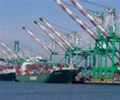

Trade at the top-ranked Port of Los Angeles is growing 48% faster than the national average this year, led by imports of computers and furniture.
That trade growth puts it on the cusp of a milestone for not only the Port of Los Angeles but all U.S. airports, seaports and border crossing.
This is the first in a series of columns I am writing focused on the nation’s top “ports” — airports, seaports or border crossings — and how they are faring compared not only to last year, in the midst of the pandemic, but previous, more normal years.
This will include a look at top trade partners, top exports and top imports for each — and some of the factors influencing the results.
I will include a look at Chicago’s O’Hare International Airport, Port Laredo in Texas, New York’s JFK International Airport, the Port of Newark and Elizabeth Marine Terminal in New Jersey, the Port of Houston, Detroit’s Ambassador Bridge, the Port of New Orleans, Los Angeles International Airport and the Port of Savannah.
While a great deal of Port of Los Angeles’ super-sized gains can be explained by the crushing collapse of U.S. trade in April of May of last year thanks to Covid-19, the Southern California port’s trade is nevertheless recovered that ground and more.
Through May, the most recent data available, Port of Los Angeles trade totaled $121.67 billion, a record pace and 7.27% above the 2018 record. The question: Will the pace continue through the end of the year?
Since 2011, the port has been the nation’s only airport, seaport or border crossing to top $100 billion through the first five months of a year, with two exceptions: In 2020, when it’s total trade fell below that mark, and this year, when Chicago’s O’Hare International topped $100 billion for the first time.
Given that the port’s trade is currently better than 7% ahead of the 2018 record, it could not only fly by the $298.65 billion year-end total but also become the first U.S. port to ever top $300 billion in annual trade.
Given that 90% of the value of its trade is in imports, it is those imports that will be the determining factor.
If the port does top $300 billion, it will do with some familiar top trade partners but some pandemic-influenced imports.
Through May, that trade growth is being led by imports from China and Vietnam. China dominates port trade, accounting for 42% of its total exports and imports through May. Japan is a distant second at 13% and Vietnam follows at 10%.
Port imports from China are up 48.39% year-to-date while those from Vietnam are up 63.21%. Overall, Port of Los Angeles imports are up 34.15% on the year. By way of comparison, U.S. imports are up — again, this is compared to the first five months of 2020 — a less-impressive but still significant 21.72%.
Two of the fastest-growing top imports at the Port of Los Angeles this year are computers, up 81.84%, and furniture and parts, up 67.77%.
Because the port’s role in U.S. trade is largely as an import destination for Asian trade — its top 10 total trade partners are all Asian — it leads the nation in many categories of imports.
Included are not only furniture but seats, children’s toys, exercise equipment and printers, but those are the biggest by value. Growth in imports of exercise equipment, similar to computers and furniture, can be at least partially linked to the pandemic, office workers heading home, and an influx of federal dollars into the economy.
The port is, of course, not without its exports, even if they only make up 10% of the total by value.
Two — cotton and scrap iron and steel — are used to make something else, something that very well might find its way back to the United States, possibly through the Port of Los Angeles. The frozen beef and passenger vehicles are ready for consumption and use, respectively, as are the prepared foods and beverages.
Two-thirds of the cotton is headed for China and Vietnam — the two fast-growing import partners. So far this year, 51% of the frozen beef is headed to South Korea, with another 20% to Japan and 20% to China.
Slightly more than a third of the motor vehicles are heading to just three countries this year, the United Araba Emirates, China and, perhaps surprisingly, Japan. A quarter of the scrap iron and steel heads to Taiwan, with 52% headed to Taiwan plus South Korea and Vietnam. China accounts for 0.46% of the total.
The port’s top trade partners for exports look quite similar to those on the import side, with only minor shuffling in the ranking.
Essentially, South Korea and Vietnam trade places. That is, of course, largely due to the fact that South Korea’s economy is far more advanced than Vietnam’s, giving its people the financial wherewithal to afford, for example, U.S. beef.
Source: Forbes